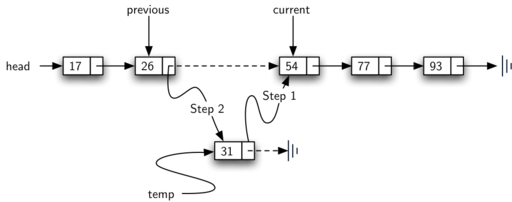Implementing an Ordered List
In order to implement the ordered list, we must remember that the relative positions of the items are based on some underlying characteristic. The ordered list of integers given above (17, 26, 31, 54, 77, and 93) can be represented by a linked structure as shown below. Again, the node and link structure is ideal for representing the relative positioning of the items.

To implement the OrderedList class, we will use the same technique as
seen previously with unordered lists. We will subclass UnorderedList and
leave the __init__ method intact as once again, an empty list will be
denoted by a head reference to None.
from unordered_list import Node, UnorderedList
class OrderedList(UnorderedList):
As we consider the operations for the ordered list, we should note that
the is_empty and size methods can be implemented the same as with
unordered lists since they deal only with the number of nodes in the
list without regard to the actual item values. Likewise, the remove
method will work just fine since we still need to find the item and then
link around the node to remove it. The two remaining methods, search
and add, will require some modification.
The search of an unordered linked list required that we traverse the
nodes one at a time until we either find the item we are looking for or
run out of nodes (None). It turns out that the same approach would
actually work with the ordered list and in fact in the case where we
find the item it is exactly what we need. However, in the case where the
item is not in the list, we can take advantage of the ordering to stop
the search as soon as possible.
For example, the diagram below shows the ordered linked
list as a search is looking for the value 45. As we traverse, starting
at the head of the list, we first compare against 17. Since 17 is not
the item we are looking for, we move to the next node, in this case 26.
Again, this is not what we want, so we move on to 31 and then on to 54.
Now, at this point, something is different. Since 54 is not the item we
are looking for, our former strategy would be to move forward. However,
due to the fact that this is an ordered list, that will not be
necessary. Once the value in the node becomes greater than the item we
are searching for, the search can stop and return False. There is no
way the item could exist further out in the linked list.

Below we provide an adaptation of the search method from our UnorderedList
class to take advantage of this optimization.
def search(self, item):
current = self.head
while current is not None:
if current.value == item:
return True
if current.value > item:
return False
current = current.next
return False
The most significant method modification will take place in add.
Recall that for unordered lists, the add method could simply place a
new node at the head of the list. It was the easiest point of access.
Unfortunately, this will no longer work with ordered lists. It is now
necessary that we discover the specific place where a new item belongs
in the existing ordered list.
Assume we have the ordered list consisting of 17, 26, 54, 77, and 93 and
we want to add the value 31. The add method must decide that the new
item belongs between 26 and 54. Below we show
the setup that we need. As we explained earlier, we need to traverse the
linked list looking for the place where the new node will be added. We
know we have found that place when either we run out of nodes (current
becomes None) or the value of the current node becomes greater than
the item we wish to add. In our example, seeing the value 54 causes us
to stop.

As we saw with unordered lists, it is necessary to have an additional
reference, again called previous, since current will not provide
access to the node that must be modified.
Once we have identified the position at which to add our new node, we
construct it and place it correctly, either as the new head of the node (if
previous is None) or between previous and current otherwise.
def add(self, item):
current = self.head
previous = None
while current is not None:
if current.value > item:
break
previous, current = current, current.next
temp = Node(item)
if previous is None:
temp.next, self.head = self.head, temp
else:
temp.next, previous.next = current, temp
We leave the remaining methods as exercises. You should carefully consider whether the unordered implementations will work given that the list is now ordered.
Analysis of Linked Lists
To analyze the complexity of the linked list operations, we need to
consider whether they require traversal. Consider a linked list that has
n nodes. The is_empty method is since it requires one step to
check the head reference for None. size, on the other hand, will
always require steps since there is no way to know how many nodes
are in the linked list without traversing from head to end. Therefore,
length is . Adding an item to an unordered list will always be
since we simply place the new node at the head of the linked list.
However, search and remove, as well as add for an ordered list,
all require the traversal process. Although on average they may need to
traverse only half of the nodes, these methods are all since in
the worst case each will process every node in the list.
You may also have noticed that the performance of this implementation differs from the actual performance given earlier for Python lists. This suggests that linked lists are not the way Python lists are implemented. The actual implementation of a Python list is based on the notion of an array. We discuss this in depth later.